When traveling on foot, one of the most significant factors in comfort and ability to keep going is the condition of your feet. After all, they’re literally what you’re walking on. An injury, an infection, frostbite, or even a bad blister could leave you wincing with every step—and moving much too slowly to escape a dangerous situation. Fortunately, it shouldn’t take much to keep your feet functioning while on the go: just a good pair of shoes, some basic daily care, and the knowledge to prevent and treat a few common problems.
Start with the Right Shoes
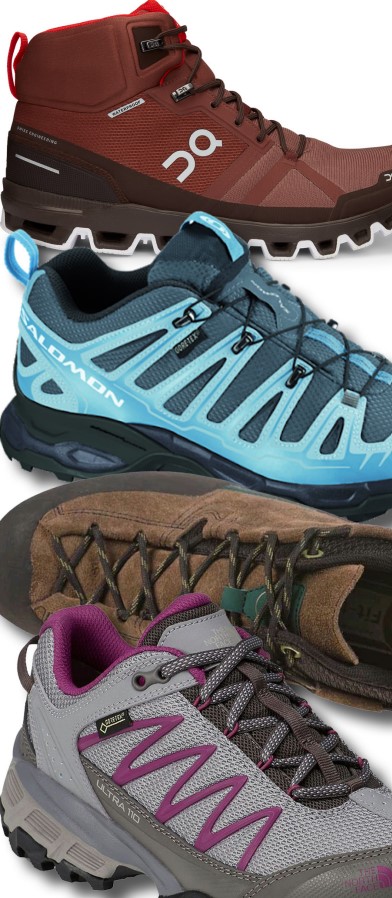 If you’ve ever gone hiking in a poorly fitting pair of boots, I don’t have to tell you how important this is—and if not, listen up. Your shoes are your first line of defense against everything the roads and trails throw at your feet. However, the wrong pair can turn traitor and cause you as much trouble as the right ones would prevent.
If you’ve ever gone hiking in a poorly fitting pair of boots, I don’t have to tell you how important this is—and if not, listen up. Your shoes are your first line of defense against everything the roads and trails throw at your feet. However, the wrong pair can turn traitor and cause you as much trouble as the right ones would prevent.
Any shoe you plan to bug out in should be of good quality, with a thick sole that can handle many miles of wear. Beyond that, which style to choose depends partly on the terrain and weather you’ll be traveling through and partly on personal preference.
The biggest distinction I’d draw among the many trail shoes and hiking boots on the market is whether they’re built as barriers—to keep out water or hold in heat—or to breathe, with thinner, permeable uppers. In warm and relatively dry conditions, the latter type is great: breathable shoes let sweat evaporate from your feet, and if they get wet, they’ll dry as you walk. Breathable shoes also tend to be lighter than barrier shoes, which will save you energy over time. But if you’ll be traveling through a consistently wet environment, like a swamp or somewhere prone to day-long rainstorms, you’ll want the protection of waterproof boots (and maybe also gaiters to extend that protection up to your shins). And if you expect temperatures anywhere near freezing, you’ll want insulation, too.
Other factors are also worth considering, like how much ankle support a shoe provides (the heavier the load you plan to carry, the more support you’ll want) and how well each particular model fits your particular feet. There’s no way to tell that last one without trying the shoes on—for that reason, I’d recommend against buying a new model of shoe for the first time online.
When you go in to try on shoes, do your best to mimic the conditions you’ll be using them in. Take a long walk first or spend the day on your feet— feet expand as they’re walked on, so if you go in cold, you might end up buying the wrong size. Wear the same socks you plan to wear in the field. Walk a short way in the shoes and try them out on stairs and rough surfaces if any are available. You want the shoes to feel snug but not tight, with room for your toes to wiggle. If you fall between two sizes, go with the larger one: you can always switch to thicker socks or pad the toes of a tooloose shoe, but there’s no fixing a too-tight one.
Once you’ve bought your bug-out shoes, make sure to break them in. Wear them around the yard for a while or take them on a few test hikes. That way, they’ll be ready to wear when you need them, and if they do end up causing you problems, you’ll know before it’s too late to find another pair.
Basic Care
A basic foot-care regimen starts when you first put on your socks and shoes. Your socks should be dry, or as dry as you can get them. (An extra pair—or three—to swap in when your first ones get wet or dirty is well worth the pack weight.) Choose wool or synthetic fibers over cotton: those fabrics are better insulators and dry more quickly. Before you put your shoes on, shake out any debris (or biting insects) that might have gotten into them. Lace them firmly enough to keep your feet stable in your shoes, but not so tight that they restrict your circulation. (If you see marks on the tops of your feet when you take your shoes off, they were laced too tight.)
Whenever you stop to rest, check your feet. Are your laces still tight? Have pebbles, twigs, or sand gotten inside your shoes? Do you feel any blisters or sore spots forming? (If so, treat them now—see the next section.) And if you’ll be off your feet for more than a few minutes, it’s good to take your shoes off, or at least loosen the laces, and air your feet for a bit, especially if you’re wearing barrier-type shoes that don’t allow much airflow.
At the end of the day, before you cool down too much, take a moment to stretch out your feet (and your leg and ankle muscles too, while you’re at it). Don’t be surprised if your feet get tender once you’ve taken your weight off them for a while. This tenderness is normal, often caused by that same swelling I mentioned earlier, and it should go away with rest. To help it along and to reduce any muscle soreness in your feet and calves, after stretching, you can soak your legs in cold water (like a lake or stream) for around 15 minutes. Be alert to any other, sharper pains in your feet: those could indicate a musculoskeletal injury in the making.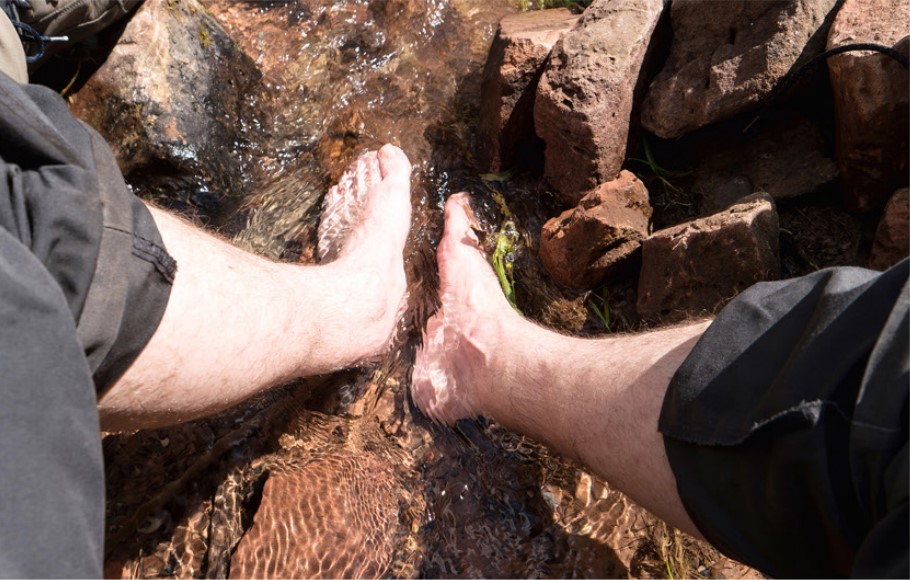
After soaking your feet, clean any debris off them, dry them as completely as you can, and check for injuries, blisters, or rashes that might need treating. Make sure your toenails are trimmed and clean, too—you don’t want them scraping against your boot, or your other toes, as you walk. Do your best to keep your feet dry as you sleep, and let your shoes dry too: set them by the fire in the evening and keep them covered overnight, so they don’t get rained on.
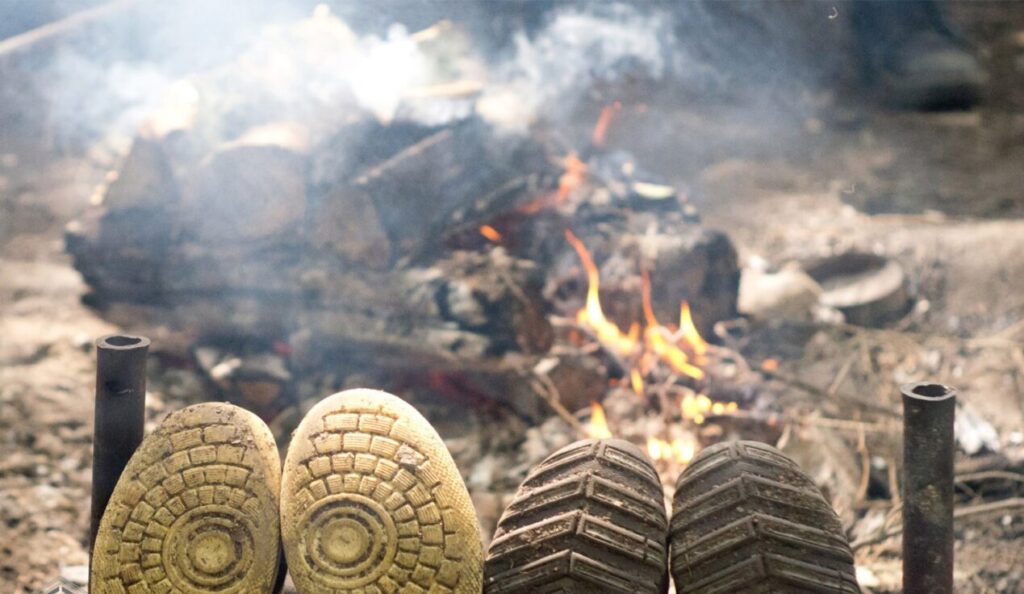
Blisters and Injuries
By far, the most common foot injury from long-distance walking is blisters: pockets of fluid that form between layers of skin when that skin undergoes too much friction. Every blister I’ve experienced in my many miles of hiking has had a distinct—and preventable—cause: too-small shoes, toolong toenails, worn-out socks leaving my heel to rub against the back of my shoe. But some people seem to get them no matter how well they treat their feet, and on a flight to safety, anyone might end up neglecting preventive care for more urgent concerns.
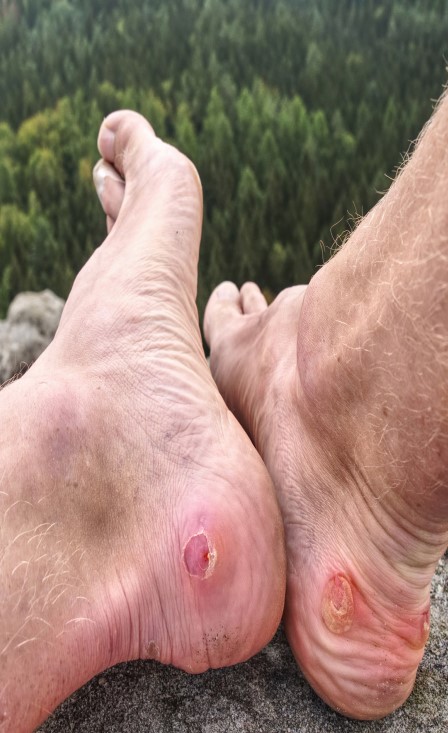 Fortunately, blisters aren’t hard to deal with, especially if you catch them early. When you notice one, change out your socks and remove any irritants that might be causing the blister (or, if the irritant is your shoe itself, tape over the affected area with moleskin, band-aids, or duct tape). If the blister has already formed but is still small and unbroken, tape it over and let it heal on its own. If it’s intact but too large or painful to walk on, you’ll have to drain it. Disinfect a needle with rubbing alcohol or by holding it in a flame until the tip glows red, then puncture the blister near its edge and let the fluid drain out. Leaving the skin in place, apply petroleum jelly or another antibacterial ointment to the blister and cover the area with a bandage or gauze. If the blister has already broken, cut away any dirty skin around it, wipe the area clean, and follow those same steps to cover it.
Fortunately, blisters aren’t hard to deal with, especially if you catch them early. When you notice one, change out your socks and remove any irritants that might be causing the blister (or, if the irritant is your shoe itself, tape over the affected area with moleskin, band-aids, or duct tape). If the blister has already formed but is still small and unbroken, tape it over and let it heal on its own. If it’s intact but too large or painful to walk on, you’ll have to drain it. Disinfect a needle with rubbing alcohol or by holding it in a flame until the tip glows red, then puncture the blister near its edge and let the fluid drain out. Leaving the skin in place, apply petroleum jelly or another antibacterial ointment to the blister and cover the area with a bandage or gauze. If the blister has already broken, cut away any dirty skin around it, wipe the area clean, and follow those same steps to cover it.
If your feet suffer any other superficial injuries as you walk, like cuts, scrapes, or bug bites, clean them thoroughly and cover them as soon as you notice them. Your feet will be spending a lot of time in an enclosed, lukewarm, often moist space: the perfect breeding ground for bacteria. The longer you leave broken skin untended in those conditions, the greater your risk of infection.
And if you develop a musculoskeletal injury—if you start feeling sharp pains inside your foot or soreness that lingers over several days—slow your pace as much as you safely can. These injuries are caused by overexertion; pushing on through them will only make them worse. It can also help to cut weight from your pack: see if you can redistribute items to your companions or leave any nonessentials behind. But the only cure for musculoskeletal injuries is prolonged rest, which might not be an option until you get to safety.
Water
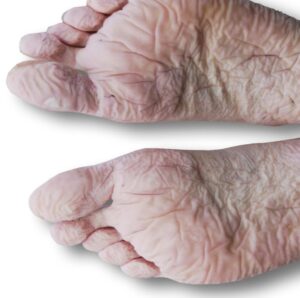 On a long journey on foot, water is your enemy. Even in the best conditions, exposure to moisture weakens the skin on your feet and leaves you more susceptible to blisters and infections. And if it’s chilly, the combination of cold and moisture can degrade the flesh of your feet, causing a condition known as trench foot. After as little as half a day in such conditions, the flesh will wrinkle, turn pale, tingle, go numb, and eventually die off. But up until that last point, treating trench foot is as easy as reversing those conditions: dry your feet and keep them warm and well-aired for a while, and they should heal back to normal.
On a long journey on foot, water is your enemy. Even in the best conditions, exposure to moisture weakens the skin on your feet and leaves you more susceptible to blisters and infections. And if it’s chilly, the combination of cold and moisture can degrade the flesh of your feet, causing a condition known as trench foot. After as little as half a day in such conditions, the flesh will wrinkle, turn pale, tingle, go numb, and eventually die off. But up until that last point, treating trench foot is as easy as reversing those conditions: dry your feet and keep them warm and well-aired for a while, and they should heal back to normal.
Better yet, don’t let your feet stay wet in the first place. Rotate your socks through the day to keep sweat from collecting in them. (If it’s dry weather, you can hang used socks from your pack to air as you walk.) Avoid stepping in puddles and bogs if you can help it. And if you can’t help soaking your shoes (if you need to cross a stream, for example, or to keep walking through a heavy rainstorm), stop to shake the water out of them as soon as possible, and dry them as best you can before continuing on.
Cold
Exposure to cold can bring even more problems for your feet. Like all extremities, the feet (especially the toes) are vulnerable to frostbite or freezing. As frostbite develops, your flesh will go numb, then turn red, then harden and turn waxy white or gray. Walking through cold water or snow without the right barrier footwear can also pull enough heat from your body to drop your core temperature dangerously low, causing hypothermia. Yet another reason to choose your shoes well.
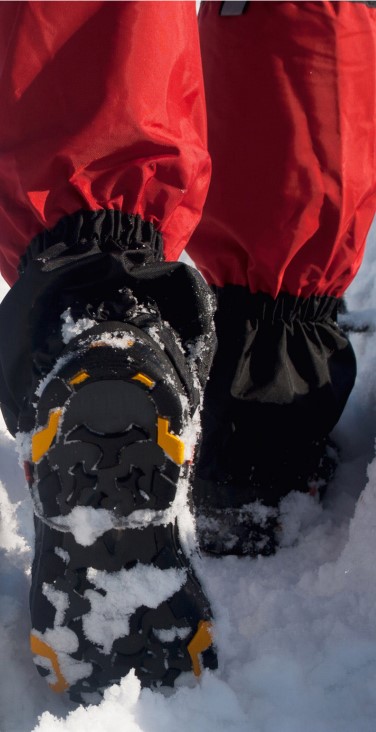
Preventing frostbite all comes down to circulation and insulation. The human body is built to generate heat, and it does that quite well if you keep it fed, in motion, and appropriately dressed for the weather. The trick is to keep heat flowing steadily from your core to your feet and to hold it in once it’s there. When you travel through cold weather, keep a steady pace, and put on extra layers when you stop to rest (and your circulation slows). Wear insulated boots and thick, moisture-wicking socks (but not so thick they make your boots too tight). Pay close attention if your toes or heels go numb: you may need to slide in a foot warmer, loosen your laces to allow better circulation or stop for a bit to warm them up.
And if you find your toes frostbitten, wait to treat them until you get to a warm, sheltered area where you can rest for a while. First, wrap yourself in a blanket and drink warm fluids to restore your core temperature; frostbite and hypothermia often go hand in hand. Next, slowly rewarm the frostbitten areas in a warm (not hot!) water bath or by having a companion hold them in his or her armpit. Once your flesh rewarms, it might hurt or swell; aspirin or ibuprofen will ease both symptoms. If any blisters form, don’t drain them—they’re meant to guard the healing flesh below. The less pressure you put on that flesh, the better, so take it slow the next day if you can. And whatever you do, don’t let that flesh re-freeze: the second round of frostbite will do much more damage than the first.
On any long walk, your feet will take a beating; when bugging out on foot, they might have to endure much worse. Fortunately, they’re up for it: the human body has evolved over millennia to excel at long-distance two-footed travel. If you’ve got the right shoes, keep your feet clean and dry, and proactively treat any problems that arise, there’s no reason you can’t walk yourself to safety.
This article was written by Laura Handley and originally published in Survival Dispatch Insider Volume 4 Issue 3.
